 To enhance service speed and avoid tariff delays, we've opened a US warehouse. All US orders ship directly from our US facility.
To enhance service speed and avoid tariff delays, we've opened a US warehouse. All US orders ship directly from our US facility.
| Cat. No. | Product Name | Field of Application | Chemical Structure |
|---|---|---|---|
| A733 | E-6071 Biosimilar(Anti-CCL20 Reference Antibody ) Featured |

|
|
| A732 | Carlumab Biosimilar(Anti-CCL2 / MCP1 Reference Antibody) Featured |
Carlumab (CNTO 888) is a human anti-CCL2 (chemokine ligand 2) antibody with high affinity. Carlumab can be used in cancer research, particularly in prostate cancer.
More description
|
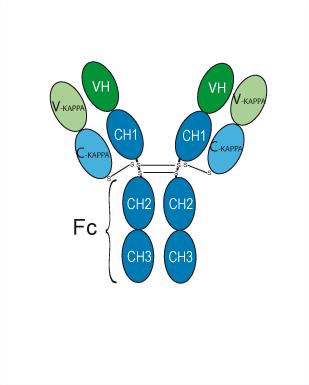
|
| A731 | GFB-024 Biosimilar(Anti-CB1 / CNR1 Reference Antibody) Featured |

|
|
| A730 | Nimacimab Biosimilar(Anti-CB1 / CNR1 Reference Antibody) Featured |

|
|
| A729 | Toray patent anti-Caprin-1 Biosimilar(Anti-CAPRIN1 Reference Antibody) Featured |

|
|
| A728 | Erenumab Biosimilar(Anti-CALCRL / CGRPR Reference Antibody) Featured |
Erenumab is a fully human monoclonal antibody. Erenumab inhibits the calcitonin gene–related peptide (CGRP) receptor. Erenumab can be used for the prevention of episodic migraine.
More description
|
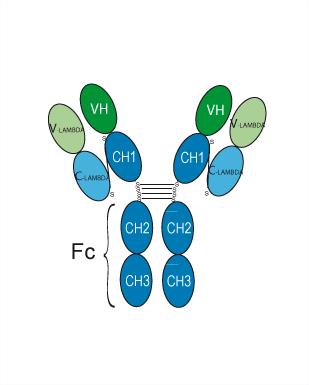
|
| A727 | Fremanezumab Biosimilar(Anti-CALCA / CGRP Reference Antibody) Featured |
Fremanezumab (TEV-48125) is a humanized IgG2a monoclonal antibody that selectively and potently binds to calcitonin gene-related peptide (CGRP). CGRP is a 37-amino acid neuropeptide involved in central and peripheral pathophysiological events of migraine. Fremanezumab has the potential for chronic migraine research.
More description
|
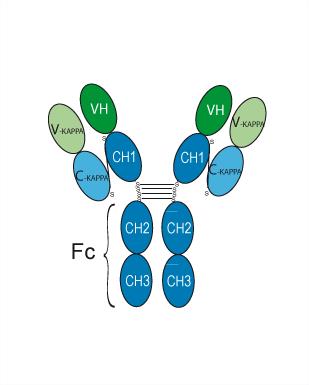
|
| A726 | Galcanezumab Biosimilar(Anti-CALCA / CGRP Reference Antibody) Featured |
Galcanezumab (LY 2951742) is a humanized IgG4 monoclonal antibody against the CGRP ligand. Galcanezumab can be used for migraine or cluster headaches research.
More description
|
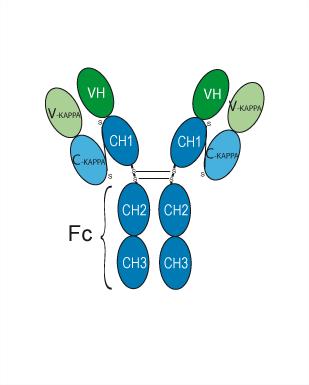
|
| DC74393 | BI-8128 Featured |
BI-8128 is a potent, selective, reversible and orally bioavailable fourth generation EGFR inhibitor, potently inhibits oncogenic EGFR variants del19 and L858R as well as the acquired EGFR resistance mutations T790M and C797S.
More description
|

|
| DC12145 | DLinDMA Featured |
DLin-DMA is an ionizable amino lipid with cationic properties and a pKa of 6.7. It is widely utilized in lipid nanoparticle (LNP) formulations alongside helper lipids to enable efficient nucleic acid delivery.
More description
|
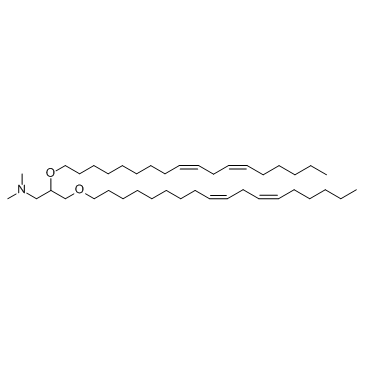
|
| DC37810 | Phenylacetylglutamine Featured |
Phenylacetylglutamine is used as biomarker for metabolic age.
More description
|

|
| DC67510 | Fluorocholine chloride Featured |
Fluorocholine chloride serves as a versatile biochemical tool for life science investigations, functioning both as an organic compound and biological marker in various research applications.
More description
|
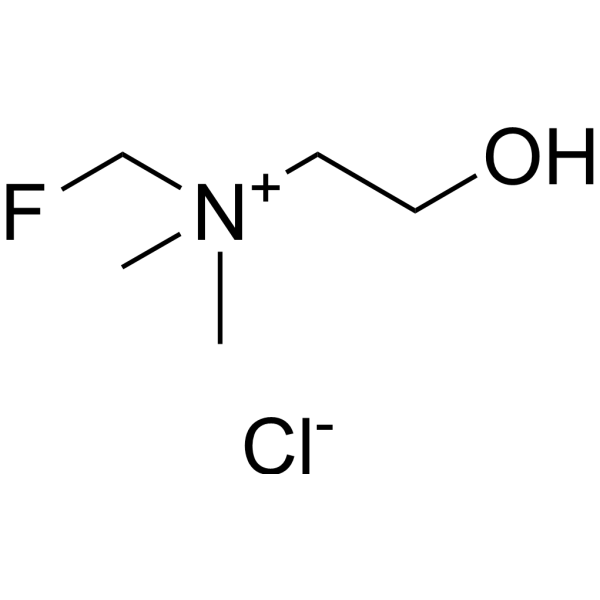
|
| DC60836 | Frutinone A Featured |
Frutinone A, a bioactive flavanone isolated from Rhus species, exhibits significant cytotoxic, antimicrobial, and anti-inflammatory properties. Studies have shown that Frutinone A inhibits cancer cell proliferation with IC₅₀ values in the low micromolar range (e.g., ~5-10 µM in certain cancer cell lines). It also demonstrates antibacterial activity against Gram-positive bacteria like Staphylococcus aureus with MIC values around 10-25 µg/mL. Additionally, Frutinone A exerts anti-inflammatory effects by inhibiting nitric oxide (NO) production in LPS-stimulated macrophages with an IC₅₀ of approximately 15-20 µM. These bioactivities make it a potential lead compound for further pharmaceutical development.
More description
|

|
| DC60835 | CIB-L43 Featured |
CIB-L43 is a TRBP inhibitor. CIB-L43 exhibits a nanomolar inhibitory activity with an EC₅₀ of 0.66 nM and a dissociation constant (K_D) of 4.78 nM, indicating strong binding affinity to TRBP. CIB-L43 effectively disrupts the TRBP-Dicer interaction, with an IC₅₀ of 2.34 μM, leading to suppression of oncogenic miR-21 biosynthesis. This suppression results in increased expression of PTEN and Smad7, thereby inhibiting AKT and TGF-β signaling pathways, which are essential for hepatocellular carcinoma (HCC) cell proliferation and migration. In vivo studies demonstrate that CIB-L43 has favorable pharmacokinetics, including 53.9% oral bioavailability, and exhibits antitumor efficacy comparable to sorafenib, a first-line anticancer drug, but with lower toxicity. These findings position CIB-L43 as a promising candidate for HCC treatment, combining potent TRBP inhibition with favorable drug-like properties.
More description
|

|
| DC48753 | DC-LC3in-D5 Featured |
DC-LC3in-D5 acts as an autophagy inhibitor by attenuating LC3B lipidation. DC-LC3in-D5 binds with LC3B. DC-LC3in-D5 disrupts the LC3B-LBP2 interaction with an IC50 of 200 nM. DC-LC3in-D5 may contribute to anti-HCV or combination treatments in cancer through inhibiting autophagy.
More description
|

|
| DC60834 | LXG6403 Featured |
LXG6403 is a potent, irreversible lysyl oxidase (LOX) inhibitor with an IC₅₀ of 1.3 μM in MDA-MB-231 cells, demonstrating approximately 3.5-fold selectivity over LOXL2 and no activity against LOXL1. It effectively inhibits LOX activity across multiple triple-negative breast cancer (TNBC) cell lines, including HCC143, Hs-578-T, and HCC1937, with IC₅₀ values below 5 μM. In preclinical models, LXG6403 enhances chemosensitivity to agents such as doxorubicin, cisplatin, and paclitaxel by disrupting collagen crosslinking, thereby reducing tumor stiffness, improving drug penetration, inhibiting FAK signaling, and inducing ROS-mediated DNA damage leading to G1 arrest and apoptosis. Notably, in the TM01278 TNBC patient-derived xenograft model, LXG6403 overcame doxorubicin resistance without significant toxicity, underscoring its potential as a therapeutic agent in LOX-driven, chemoresistant cancers
More description
|

|
| DC60833 | Rtioxa-43 Featured |
RTIOXA-43 is a dual orexin receptor agonist exhibiting potent activity at both OX1 and OX2 receptors, with EC₅₀ values of 24 nM for each . In vivo studies involving 12-month-old mice have demonstrated that peripheral administration of RTIOXA-43 significantly increases wakefulness, reduces total sleep time, and enhances sleep/wake consolidation by decreasing the number of sleep episodes and extending their duration . These findings suggest that RTIOXA-43 holds promise as a therapeutic candidate for treating orexin-deficient conditions such as narcolepsy.
More description
|

|
| DC22090 | ER-464195-01 Featured |
ER-464195-01 is a specific, orally active inhibitor that inhibits Calreticulin (CRT) binding to integrin α subunits (ITGAs) with IC50 of 0.17, 0.36, and 0.23 uM in the interaction between CRT and ITGA α4, αL, and αM/α2/α5.
More description
|

|
| DC60832 | GJG057 Featured |
GJG057 is a LTC4S inhibitor. GJG057 exhibits potent cytotoxic effects against various human cancer cell lines, including SGC-7901, HGC-27, and MCF-7, with IC₅₀ values of 20.5 ± 5.93 μM, 3.3 ± 2.53 μM, and 16.6 ± 0.75 μM, respectively. Notably, GJG057 shows high selectivity towards cancer cells over normal cells. Mechanistic investigations revealed that GJG057 induces apoptosis in a concentration-dependent manner and downregulates the expression of HIF-1α, VEGF, and PKM2, leading to decreased lactate production. Furthermore, GJG057 effectively inhibits tubulin assembly, suggesting its potential as a multi-target anti-tumor agent.
More description
|
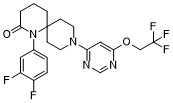
|
| DC73897 | AGF347 Featured |
AGF347 (AGF-347) is a small molecule inhibitor targeting mitochondrial C1 metabolism at SHMT2 (in vitro Ki=2.19 uM), also directly targers the purine biosynthetic enzymes GARFTase (Ki=3.13 uM) and AICARFTase (Ki=3.72 uM), and SHMT1 (Ki=2.91 uM).
More description
|

|
| DCC0193 | 2-furoyl-ligrlo-amide Featured |
2-Furoyl-LIGRLO-amide is a potent and selective proteinase-activated receptor 2 (PAR2) agonist with a pD2 value of 7.0.
More description
|

|
| DC23017 | R 59022 Featured |
A small molecule inhibitor of diacylglycerol kinase (DGK) with IC50 of 2.8 uM, inhibits the phosphorylation of OAG to OAPA with IC50 of 3.8 uM in intact platelets.
More description
|

|
| DC60831 | VLS-1272 Featured |
VLS-1272 is an orally bioavailable, potent, ATP non-competitive, microtubule-dependent, and highly selective inhibitor of KIF18A. VLS-1272 is selective for KIF18A over other kinesins, with no inhibition of KIF11/Eg5, KIF18B, or KIFC1 at 100 µM, and IC50 of 280 nM against KIF19. VLS-1272 treatment results in mitotic defects leading to substantial, dose-dependent inhibition of tumor growth.
More description
|
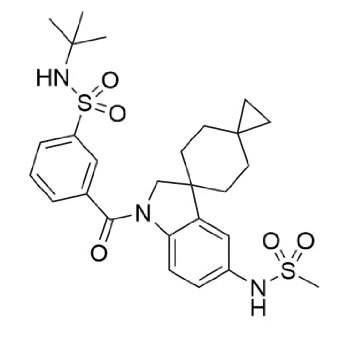
|
| DC60830 | HM-279 Featured |
HM-279 is a potent ALK5 inhibitor with IC50 of 4.7 nM. HM-279 shows cross-reactivity with ALK7 (IC50 of 6.8 nM), but HM-279 has fair to good selectivity against other TGF-β receptor family kinases, with 4.5-693 fold selectivity.
More description
|
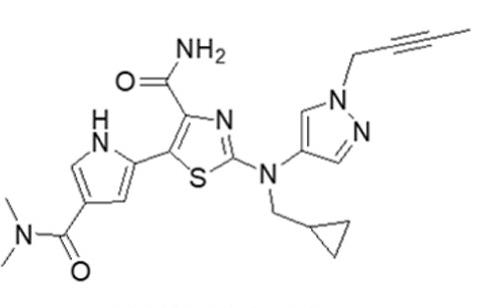
|
| DC60829 | DGEM3 Featured |
dGEM3 is a novel VHL molecular glue that targets the survival of motor neuron (SMN) complex member GEMIN3 for degradation. dGEM3 demonstrated a remarkable degree of selectivity for GEMIN3 recruitment directly out of the DEL screen with no other DEAD-box helicases showing any indication of recruitment or degradation.
More description
|
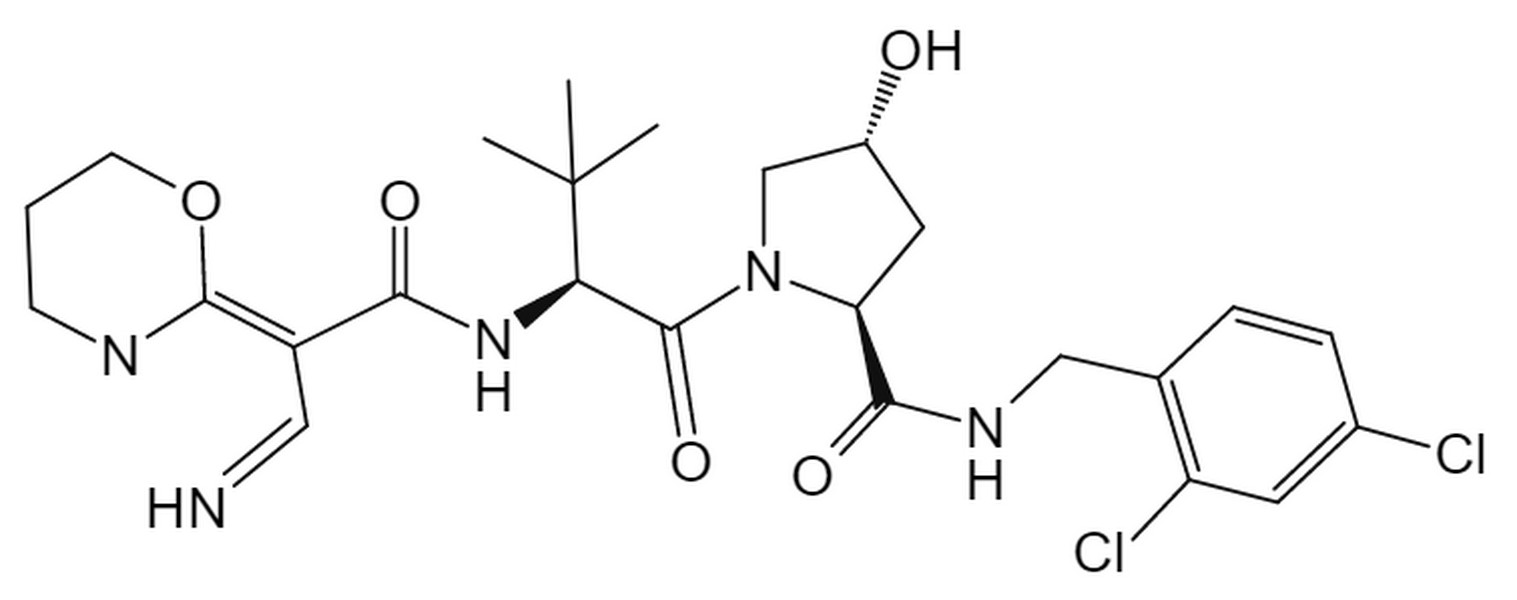
|
| DC60462 | MIC1 Featured |
MIC1 is a set of multi-charged lipids with four tertiary amino nitrogen atoms (4N4T) which could be constructed and applied to form novel lipid nanoparticles. 4N4T-LNPs based on MIC1 exhibit much higher mRNA translation efficiency than the approved SM-102-LNPs. 4N4T-LNPs are successfully applied to DS mRNA vaccine and the vaccines worked well against SARS-CoV-2 and its variants, including Delta and Omicron.
More description
|

|
| DC66649 | CP-LC-1254 Featured |
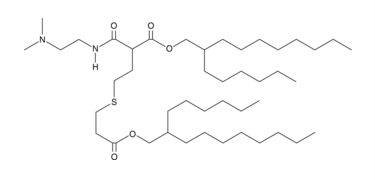
|
|
| DC21219 | LBL1 Featured |
LBL1 is a first-in-class pyrroloquinazoline small molecule that selectively targets the coiled-coil domain of lamin A (binding affinity Kd = 5.11 μM), demonstrating potent anticancer effects through nuclear lamina disruption.
More description
|

|
| DC60681 | SD-436 Featured |
SD-436 is a highly potent and selective STAT3 degrader with DC50 of 0.1 nM in human PBMCs and displays >10,000-fold degradation selectivity for STAT3 over other STAT proteins.
More description
|

|
| DC70765 | SD-36 Featured |
SD-36 (STAT3 degrader SD-36) is a potent, selective STAT3 degrader (PROTAC), potently induces the degradation of STAT3 protein in vitro and in vivo.SD-36 is designed using an analogue of CRBN ligand lenalidomide and the STAT3 inhibitor SI-109, binds to recombinant STAT3 protein with Ki of 11 nM.SD-36 (250 nM) depleted >90% of STAT3 protein in MOLM-16 cells after 4 hr treatment and >50% of STAT3 protein in DEL, KI-JK and SU-DHL-1 cells after 7 hr treatment, also efficiently degraded STAT3 protein in murine cells.SD-36 displays extremely high cellular selectivity for degradation of STAT3 over other STATs.SD-36 effectively degrades both wild-type and mutated STAT3 proteins in cells, effectively degrades mutated STAT3 (D661Y, K658R mutant), also effectively degrades CRISPR-mutated homozygous Y705F mutant STAT3 protein in DLD-1/STAT3Y705F/Y705F cells.SD-36 displayed strong growth-inhibitory activities in a subset of leukemia and lymphoma cell lines (MOLM-16 cell line IC50, 35 nM), 100-fold more potent than SI-109.SD-36 (i.v. 25 mg/kg) effectively and selectively depletes STAT3 protein, achieves complete and long-lasting tumor regression in in mouse xenograft tumors.
More description
|

|